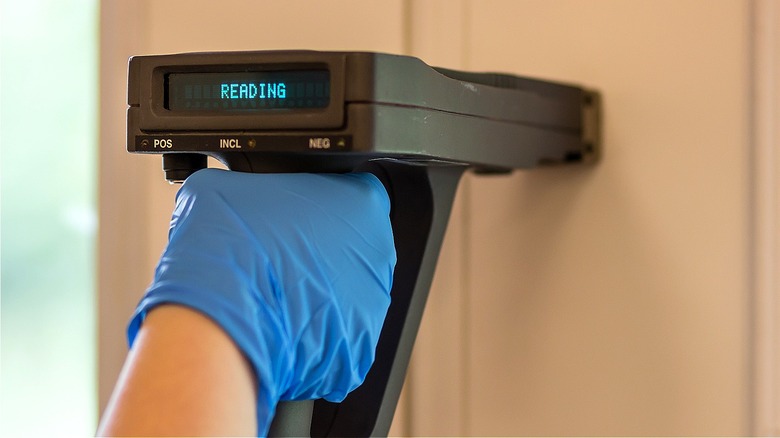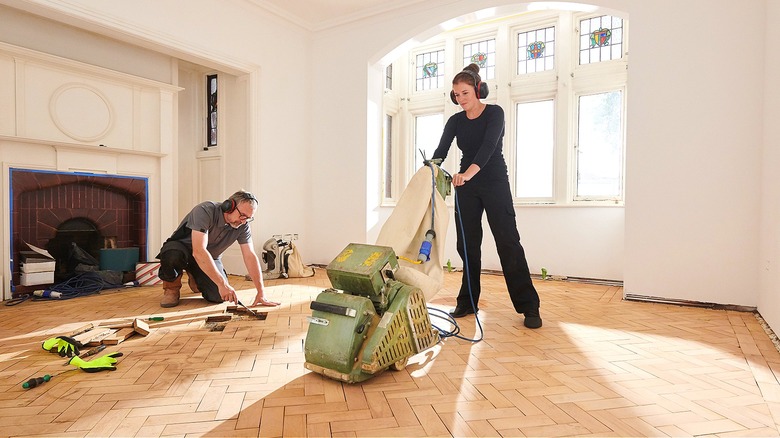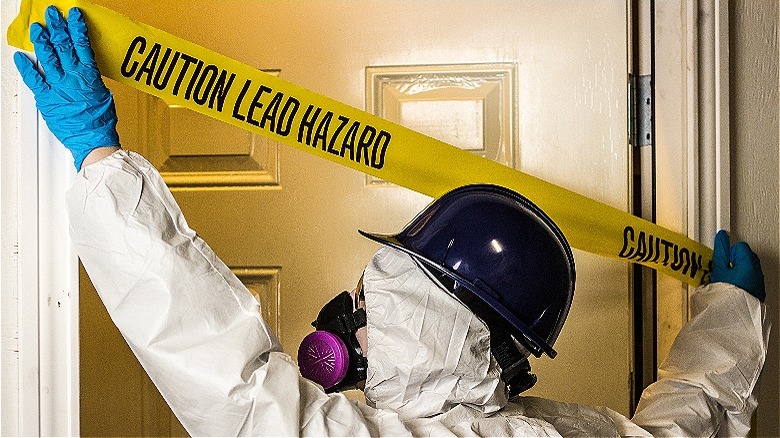The Popular Renovation Project DIYers Should Be Checking For Lead
Refinishing hardwood floors is one of the most rewarding home renovation projects, but a danger lurks in the process for some homeowners. Lead shows up in floor varnishes used before 1978, and dealing with it safely can be a challenge. According to the Environmental Protection Agency, the older a home is, the more likely it is to be contaminated with lead, with 87% of homes built or renovated before 1940 containing lead. It's usually in the form of lead-based paint, but lead was also used as a drying agent in wood varnishes, and a 2012 study in the Journal of Occupational and Environmental Hygiene on lead exposures from varnished floor refinishing found that 70% of the 25 homes tested had lead levels that were more than four times the EPA hazard standard.
There are several different tests available to help you tell if your home contains lead-based paint. That 2012 study established that sanding older floors (and especially stairs) often results in high levels of settled lead dust in a home, but the lead is also released by everyday wear and tear. Varnishes that contain lead are considered lead-based paint by the EPA, but perhaps because we don't think of varnishes and clear coats as paint, it doesn't get as much attention as ordinary pigmented paint. The lack of awareness combined with the wear floors experience makes for a risky situation for homeowners, but a very dangerous situation for those who decide to sand those floors during a renovation without being aware of the risks.
How to determine if there's lead in your flooring
As of October 2023, there's only one DIY test kit recognized by the EPA, D-Lead's Lead Paint Test Kit. (Massachusetts has its own test, which is required and only available there.) To test your hardwood floor, start by thoroughly cleaning the surface to be tested. If you have, or suspect you have, more than one layer of finish on your floor, you have to break the first rule of dealing with lead: never disturb it.
To ensure the safety of your floor renovation, you need to expose all finished layers by cutting through them at a 45-degree angle and removing a sliver of material so you can test them all for lead. Follow the package directions for testing. EPA recognition indicates the D-Lead test is pretty reliable, but a negative result for a home built before 1978 should be confirmed by sending a sample of the floor varnish to a certified lab.
Alternatively, you can have a certified professional inspector test for lead. This usually involves using a handheld XRF (X-ray fluorescence) machine, which will yield immediate results. However, there's some indication that XRF calibration isn't as reliable for floor varnish as it is for paint, so it's a good idea to have the inspector send a sample away for lab analysis as well. You should get a detailed report of where samples were taken and where lead was found, if any.
What you can do about lead in your floors
Because of daily wear, some means of containing or removing the lead is necessary for wood floors, and the EPA describes two strategies for coping with the problem. The abatement process is designed to safely and permanently eliminate lead from a home. This is an expensive process that involves specialized equipment and professionals specifically trained in lead removal. It also requires that everyone move out of the home until the process is complete.
The other way of dealing with lead in floors is a form of Renovation, Repair and Painting (RRP), in which you continue the plan to renovate floors but use methods to minimize lead hazards, like the use of encapsulant paint to seal the surface when painting over lead paint. However, when it comes to floors, which see regular use that can disturb lead-containing finishes, these precautions can be less effective than they are for traditional lead-based paint, so extra care and what the EPA calls "continued good maintenance" is necessary.
Since it's hard to know when lead is being exposed in floors without constant testing, the best strategy might be to cover the floor with another flooring like vinyl, a floating floor, or perhaps carpet with a pad that can serve as a vapor barrier. Regulations require that RRP projects on pre-1978 homes be completed by certified professionals, but homeowners renovating their own homes can generally complete the work themselves unless otherwise directed by local agencies.


